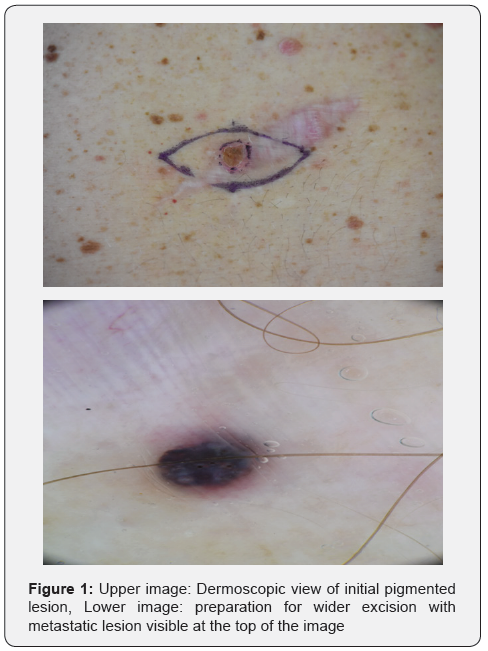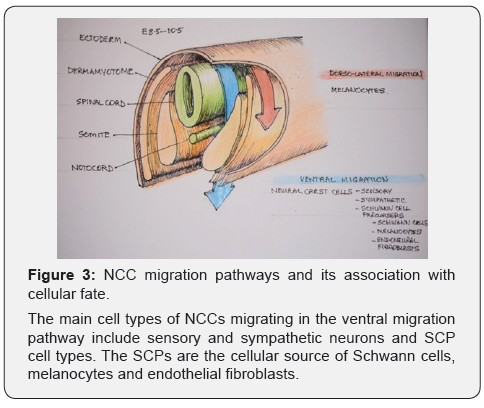Juniper Publishers- Open Access Journal of Case Studies
Fournier Gangrene, Empyema and Retroperitoneal Abscess as a Rare Complication of Perforated Appendicitis: A Case Report
Authored by Emad Aljohani
Abstract
Background: Perforated appendicitis which may be associated with the formation of localized abscess in the right iliac fossa or in the pelvic cavity, can be managed depending on their symptoms. Retroperitoneal abscess is a life-threatening condition because of its clinical manifestations and diagnostic difficulty. The retroperitoneal abscess has the potential to spread rapidly to the perinephric space, the psoas muscle, the lateral abdominal wall, and the lower extremities.
Case presentation: We present a 39 years old patient who presented to the emergency room with empyema and retroperitoneal abscess which managed conservatively with percutaneous drainage and Intravenous antibiotics. After couple of days of observation, he developed Fournier gangrene which managed by surgical debridement. CT scan on the follow up showed intraabdominal collection, emergency exploratory laparotomy along with appendectomy and washout performed. Postoperatively the patient developed perineal wound bleeding which controlled surgically. Afterwards he became severely septic, requiring maximum ionotropic support. Eventually he died due to irreversible septic shock and multiorgan failure.
Conclusion Perforated appendicitis can present with variety of complications. To the best of our knowledge from the literature review, this is the first case to be reported as Fournier gangrene, empyema and retroperitoneal abscess as unusual complication of perforated appendicitis.
Keywords: Perforated appendicitis; Fournier gangrene; Empyema; Retroperitoneal abscess
Introduction
Acute appendicitis is a disease commonly encountered in daily practice, and a very low morbidity and mortality rate can be achieved with proper diagnosis and management at present. Generally, a non-perforated acute appendicitis can be managed by urgent appendectomy, while perforated appendicitis which may be associated with the formation of localized abscess in the right iliac fossa or in the pelvic cavity, can be managed depending on their symptoms either by early appendectomy or by interval appendectomy following percutaneous drainage [1]. Retroperitoneal abscess is still recognized as a life-threatening condition even today because of its insidious clinical manifestations and diagnostic difficulty. Via congenital anatomical communications, the retroperitoneal abscess has the potential to spread rapidly to the perinephric space, the psoas muscle, the lateral abdominal wall, and the lower extremities [2]. An empyema is the result of the accumulation of infected fluid in the pleural space. Most frequently, it occurs due to infection spread by contiguity of intrathoracic disease (pneumonia, mediastinitis, etc.). The secondary infection due to intra-abdominal pathology is less common. In the absence of lung disease or other intrathoracic focus, intra-abdominal origin should be considered [3]. To date, there are no case reports documenting Fournier gangrene, empyema and retroperitoneal abscess as unusual complication of perforated appendicitis.
Presentation of Case
39 years old Eritrean male presented to the emergency department complaining of severe abdominal pain and vomiting for ten days. The patient looked sick, dehydrated, with tachycardia, tachypnea, and febrile on examination. His abdomen was soft with tenderness over the right iliac fossa. He had scrotal swelling, but wasn’t tender nor erythematous. However, DRE was unremarkable. His WBC was 15.9 (109/L). Other labs were within an acceptable range. A chest x-ray showed the presence of an air-filled cavity within the pleural cavity of the right lung (Figure 1). His abdominal x-ray showed the presence of extra-peritoneal air on the right side of the abdomen (Figure 2). After proper resuscitation, chest, abdomen, and pelvis Computed Tomography (CT) scan done. It showed a large right flank collection with multiple peritoneal fat fluid pockets and gas bubbles with a right chest empyema (Figure 3). The patient admitted and started on IV broad-spectrum antibiotics. Chest and flank percutaneous drainage performed by intervention radiology. Upon insertion of the chest and flank pigtails, a total of 60 and 700 milliliters of frank pus drained, respectively. He was shifted to the ward under observation.



The patient improved gradually, both clinically and biochemically. However, on the fourth day of his admission, his WBC increased from 9 to 30 (109/L). A thorough examination was carried out, which showed the presence of scrotal swelling, which was erythematous, warm, and tender to touch. Urgent Pelvis CT was done, and it showed the presence of gas within the soft tissues with fat stranding in the scrotum. Therefore, extensive debridement of the scrotal Fournier Gangrene was done. The patient was then shifted to the ward with daily dressing and IV antibiotics plan. Cultures showed growths of Escherichia Coli and Proteus Mirabilis, and blood culture was positive for Escherichia Coli. Infectious Diseases consulted to guide the course of antibiotics, and they opted to start Meropenem, Vancomycin, and Caspofungin. Also, HIV, Hepatitis B, and Hepatitis C screening tests were all negative.
A couple of days later, CT scan were repeated to follow the chest and retroperitoneal abscesses. It showed an interval decrease in the size of the chest abscess and increase in the size of the retroperitoneal abscess with the finding of an intraabdominal collection, which is communicating with the retroperitoneal abscess. The decision was made to take the patient to the operating room on the 12th day after admission for exploratory laparotomy. Intra-operatively, there were more than two liters of yellowish free fluid found intraperitoneally. The appendix found to be perforated with fecal matter expelled into the abdominal cavity. Thorough irrigation was done after conducting an appendectomy. The patient shifted back to the ward, where he was followed daily for dressing changes over the perineal wound.
On the second day postoperatively, the patient suddenly became septic and hemodynamically unstable. He was shifted to the ICU, which he required ionotropic support. During ICU stay developed bleeding through the perineal wound. Angiography was done to control the bleeder, which failed in localizing a bleeder. For this reason, shifted to Operating Room for bleeding control, and multiple sutures taken over the multiple small bleeders with an application of hemostatic agents. The patient was taken back to the ICU for further supportive care. Unfortunately, the patient started deteriorating the following day with increasing lactic acid levels, and the diagnosis of bowel ischemia was suspected. An abdominal CT scan was done, which showed findings suggestive of non-occlusive ischemic colitis. In the next days, the patient started deteriorating rapidly and has eventually died due to irreversible septic shock and multiorgan failure.
Discussion
Acute appendicitis is the most common abdominal emergency worldwide, and its surgical treatment is simple and effective, resulting in full recovery without adverse consequences in most cases. One of the most serious complications of acute appendicitis is retroperitoneal abscess, which can be difficult to diagnose and manage because of its insidious onset and cause [2].
The CT-diagnosed accuracy rate of retroperitoneal abscess approached 100%. This feature is consistent with the current series in which CT scan was used as the diagnostic tool of choice. However, it should be noted that even though CT can show a retroperitoneal abscess clearly, it is still problematic to identify a perforated appendix, as a correct diagnosis of perforated appendicitis was made in only 5 of 12 patients who underwent CT. This is probably because the severe inflammatory process made the appendix become necrotic and indistinguishable from abscess on the CT scan [4].
Our patient had retroperitoneal perforated appendicitis with significant dissemination of the infection to the chest, perineum and retroperitoneum. He was treated initially with conservative management with drainage of the chest empyema, and retroperitoneum collection. On the follow up CT scan found to have scrotal Fournier Gangrene which required emergency extensive debridement. On follow up CT scan an abdominal collection along with increasing retroperitoneal collection. Exploratory laparotomy, appendectomy and washout performed and shifted to the floor. Post operatively the patient shifted to the ICU as he became septic and during the ICU stay, he developed perineal wound bleeding which can’t be controlled by angiography but surgical bleeding control succeeded. He deteriorated postoperatively, CT done and showed non-occlusive bowel ischemia due to the high requirement of the ionotropic support. Eventually he developed multiorgan failure and died.
In summary, we report rare presentation retroperitoneal perforated appendicitis extending to the chest and perineum. Up to our knowledge from the literature review this is the first case report to be reported as retroperitoneal perforated appendicitis with empyema and Fournier Gangrene.
Conclusion
An empyema or lung abscess caused by an abdominal infection is a rare entity, especially as consequence of acute appendicitis. However, when a retroperitoneal infection is established, it may eventually compromise the thoracic cavity by contiguous spread. The formation of complicated retroperitoneal abscess involving the thigh, psoas muscle, perinephric space, and even the lateral abdominal wall is well recognized as a serious complication of perforated acute appendicitis. In conclusion, perforated acute appendicitis can occasionally manifest as complicated retroperitoneal abscess without remarkable abdominal symptoms; thus, it is necessary to maintain a high index of suspicion in a patient with symptoms of retroperitoneal infection. CT scan should be obtained to evaluate the possible origin and extent of the infection.
To know more about Juniper Publishers please click on: https://juniperpublishers.com/manuscript-guidelines.php
For more articles in Open Access Journal of Case Studies please click on: https://juniperpublishers.com/jojcs/index.php




No comments:
Post a Comment